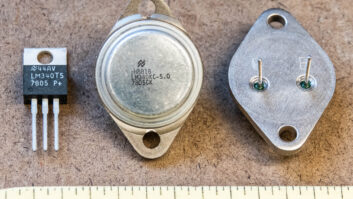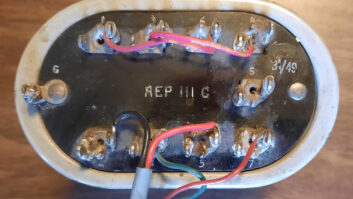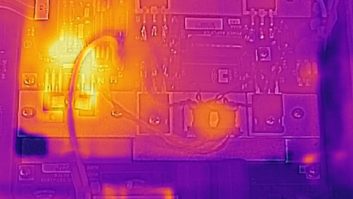Photos
(click thumbnail)Fig. 1: Make a visual inspection of the site’s phasor and ATU.
(click thumbnail)Fig. 2: The umbrella increases an air conditioner’s efficiency.
(click thumbnail)Fig. 3: Drill a plastic shelf bracket to match rack bolt spacing for an inexpensive shelf.
Crawford’s Cris Alexander was reading the Aug. 16 Workbench, which column brought to mind another AM system maintenance tip. His tip will help you spot problems before they turn into disasters.
Immediately after shutting down the transmitter after it has been operating into the antenna system for a while,ÿdisable the transmitter and remove the tower J-plugs.
This inspection will be both visual and tactile. You will visually inspect the components of the phasor and antenna tuning unit, as shown in Fig. 1. First, look for any discolored silver plating on coils and interconnecting tubing, especially at junction points that are bolted together. Then, carefully feel all the capacitors and coils in the phasor and ATUs.
Any that are much above the ambient temperature are dissipating power, reducing the efficiency of the system and possibly indicating an imminent failure. Hot capacitors can indicate that the cap is undersized for the amount of current, or signal a loose or badÿconnection or that there is something wrong with the cap.
Heat in a coil can indicate an undersized component, but more often it indicates a bad connection. The discolored silver plating is another indicator of heating. Either condition in a cap or coil is a problem and should be addressed before a failure (or fire) occurs.
It is, of course, safer to use an infrared thermometer to check component temperatures, but the old “feel test” is just as reliable. Be careful and just use one finger lightly, in case you encounter a surface hot enough to burn.
This test is best performed at night. Sun shining on tower ATUs can heat the components inside, and give a false indication of failure if the ATU box is hot.
So you don’t want to stick your hand into an ATU, even with the j-plugs pulled? Then consider temperature indicator strips. There are a variety of them on the Web. A favorite is found at www.sanitationtools.com; search there for “180F Thermolabel.”
A strip of this treated paper is applied to the side of a capacitor. The paper turns black when the temperature reaches 180 degrees. There are several temperature ranges to choose from. At $13.49 for a package of 24, it’s a good investment. These strips are sold to verify wash temperatures in commercial dishwashers! Head to Ask.com and type in “temperature indicator strips” for a variety of choices.
Cris adds that this same “heat inspection” test can be used in solid-state transmitters, particularly those with low voltage and high current. Your first step is to make the transmitter safe by removing primary power, and opening the RF output connection. Then look and carefully feel the B- (or B+) busses, conductors and connections. Any hot spots point to a problem.
Since many of these connections are usually insulated wire, look for darkened or burned wire insulation or terminal lugs. Whether you find indications of heating or not, it’s a good idea to tighten all of these connections during this down time.
Cris Alexander is the director of engineering of Crawford Broadcasting, headquartered in Colorado, and a fellow RW contributor.
* * *
After a crew thinned some of the trees around his transmitter building, Greg Lynam of WNSH(AM) in Beverly, Mass., saw a loss of efficiency in his air conditioner. Although the transmitter building is well insulated, the “hole” in the canopy was literally letting the sun shine in, more than before.
Greg was advised of a substantial delivery delay in an awning to shield the air conditioner from the sun, so he mounted the umbrella as a stopgap measure, shown in Fig. 2. It worked so well that he’s rethinking the awning idea.
Greg has been innovative inside the transmitter building, too. Needing a shelf, he modified a plastic bracket from a hardware store, drilling the bracket to fit 10×32 rack bolts. The result, shown in Fig. 3, holds his remote control keyboard and mouse – and at a fraction of the cost of a pull-out drawer.
* * *
In the previous column, we reported about vandalism and theft at transmitter sites. Although there are a variety of security measures available to you, sometimes the simplest are the best – and also least expensive.
Loud and Clean’s Grady Moates notes that when subcontractors are working at the sites he manages, he insists they close the property gate’s combination lock after entering, and reset the combo dials to 0-0-0.
Not only can someone steal an unlocked gate lock, but in the case of combination locks, if the opening combination is not changed a “smart” thief can simply write down the combination and return later. Grady admits the tips are simple, but the object is to make access to your site difficult. Open gates are inviting entry – especially at “out of the way” transmitter sites.















